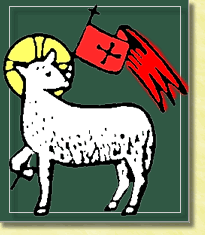Psalm 40:1-10
Isaiah 49:1-7
1 Corinthians 1:1-9
John 1:29-41
 In our gospel reading this morning, John the Baptist announces: “Behold the Lamb of God, who takes away the sin of the world.” (John 1:29). John’s statement is a brief summary of the heart of the Christian faith. Christian faith is about Jesus. Who is Jesus? He is someone who has a special relationship to God. “He is the Lamb of God.” He is also, according to John’s gospel, “the Word of God,” “the Son of God,” “the Christ,” “the Way, the Truth, and the Life,” the “Bread of life,” “the Water of life,” and a number of other things.
In our gospel reading this morning, John the Baptist announces: “Behold the Lamb of God, who takes away the sin of the world.” (John 1:29). John’s statement is a brief summary of the heart of the Christian faith. Christian faith is about Jesus. Who is Jesus? He is someone who has a special relationship to God. “He is the Lamb of God.” He is also, according to John’s gospel, “the Word of God,” “the Son of God,” “the Christ,” “the Way, the Truth, and the Life,” the “Bread of life,” “the Water of life,” and a number of other things.
What does Jesus do? He takes away the sin of the world. These are the two central affirmations of Christian faith. Lose either affirmation – who Jesus is and what Jesus does – and you no longer have Christian faith. Yet both of these affirmations have become increasingly problematic in contemporary Western culture, and, significantly enough, I think, the second more than the first.
Let me illustrate what I mean by mentioning two incidents that happened in the last several weeks, one in secular culture and one in the church. The first is the notorious Duck Dynasty incident. Phil Robertson, the star of a reality television series about a family of self-styled backwoods Bible thumpers who became millionaires from making duck calls created a cultural firestorm when he answered a question addressed to him in a magazine interview: “What in your mind is sinful?” I am not going to repeat Robertson’s answer here. You are no doubt familiar with the story.
The second event was the appearance of a new Church of England baptismal rite. Supposedly the rite had been rewritten to put it in the language of East Enders in London, who apparently could not make sense of the current rite of baptism in the Church of England’s Common Worship liturgy. What is significant about the new rite is not that the language is simplified so that East Enders can understand it, but that the language changes the actual meaning of the rite. It removes all language of sin, and all references to Jesus as Savior from sin. The baptized no longer “die to sin,” but to “all that destroys.” The baptized do not renounce sin; they renounce evil. Throughout the new liturgy, in every case in which the word “sin” appears in the current rite, the word “evil” is substituted.
What both of these incidents have in common is that they reflect the discomfort our society currently has with the notion of sin. (more…)





